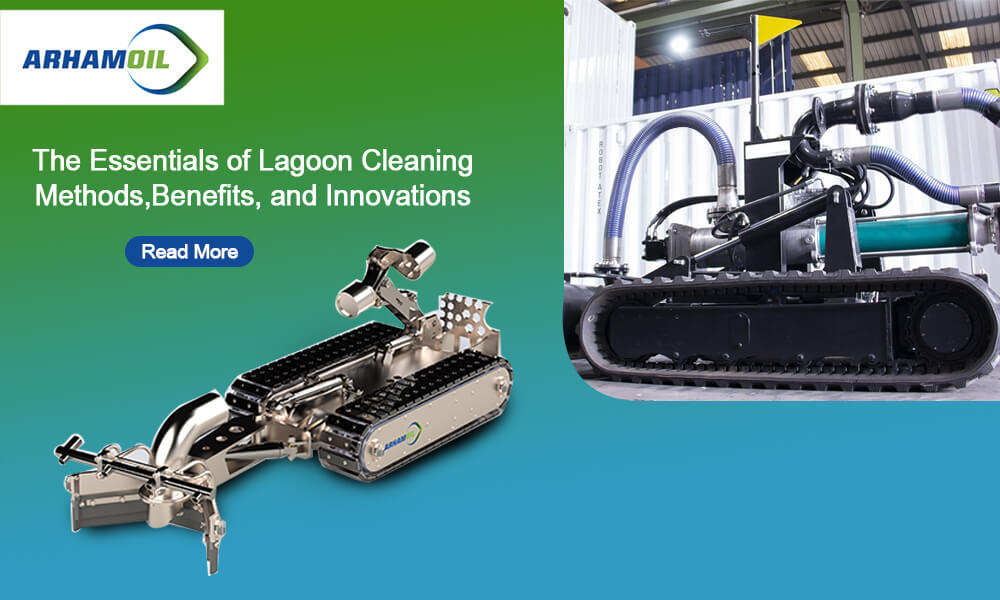Revolutionizing Safety and Efficiency: The Rise of Mechanized Tank Cleaning
April 17, 2024Advancements in Sludge Processing: Mechanized and Robotic Tank Cleaning in India
May 15, 2024Lagoon systems are widely used across various industries for wastewater treatment, especially in municipal, agricultural, and industrial sectors. These man-made basins help manage and treat wastewater through natural biological processes. Over time, however, sludge accumulates at the bottom, necessitating periodic cleaning to maintain its efficiency and compliance with environmental standards. This article explores the critical aspects of lagoon cleaning, including the methods used, their benefits, and the latest advancements in the field.
Why Clean Lagoons?
Lagoons are designed to allow microorganisms to break down organic matter in wastewater. Sludge—primarily composed of undigested solids and byproducts from bacterial decomposition—gradually builds up. Excessive sludge accumulation reduces the effective volume and surface area of the lagoon, thereby diminishing its treatment capacity and efficiency. Regular cleaning is essential to prevent overflow, odors, and potential breaches of environmental compliance regulations.
Traditional and Modern Cleaning Methods
1. Dredging:
Dredging is the most common method for sludge removal in lagoons. This process involves using a floating barge equipped with a dredge pump that sucks up the sludge. Dredged material is then either dewatered on-site or transported to a disposal facility. Dredging is effective but can be disruptive and costly, depending on the lagoon’s size and sludge volume.
2. Mechanical Removal:
This method uses machinery such as backhoes and excavators. The equipment is either placed on a barge or operated from the shore, scooping out sludge directly from the lagoon. Mechanical removal is typically quicker than dredging but requires the lagoon to be drained and can disturb the microbial ecosystems.
3. Biological Augmentation:
An innovative and less invasive method involves enhancing the natural biological processes within the lagoon. By adding specific strains of bacteria and enzymes, this method accelerates the breakdown of organic matter in the sludge, thereby reducing its volume naturally. This technique is environmentally friendly and maintains the lagoon’s operational capacity during treatment.
Benefits of Regular Lagoon Cleaning
Improved Efficiency: Regular removal of sludge ensures that lagoons can operate at optimal conditions, effectively treating wastewater as designed.
Extended Lifespan: Regular maintenance prevents the premature aging of lagoon systems, extending their serviceable life and reducing the need for costly repairs or replacements.
Environmental Compliance: Keeping sludge levels in check helps maintain the quality of the effluent within regulatory standards, avoiding fines and sanctions.
Odor Control: Accumulated sludge can cause anaerobic conditions, leading to unpleasant odors. Cleaning helps minimize these odors, improving the quality of life for nearby communities.
Innovations and Future Trends
The future of lagoon cleaning sees a shift towards more sustainable and less disruptive methods. Innovations like remote sensing technology and drones are being developed to monitor sludge levels and microbial health accurately, allowing for more targeted cleaning operations. Furthermore, the integration of artificial intelligence and machine learning could optimize the timing and method of cleaning, ensuring maximum efficiency with minimal environmental impact.
The development of more sophisticated biological treatments that can deal more effectively with complex industrial effluents is also on the rise. Such advancements promise to make lagoon cleaning more effective, less costly, and more environmentally sustainable.
Conclusion
Lagoon cleaning is a critical component of wastewater management that ensures the long-term functionality and compliance of these essential systems. As technology advances, the processes and methods of maintaining lagoons continue to evolve, offering promising prospects for both environmental conservation and operational efficiency.


